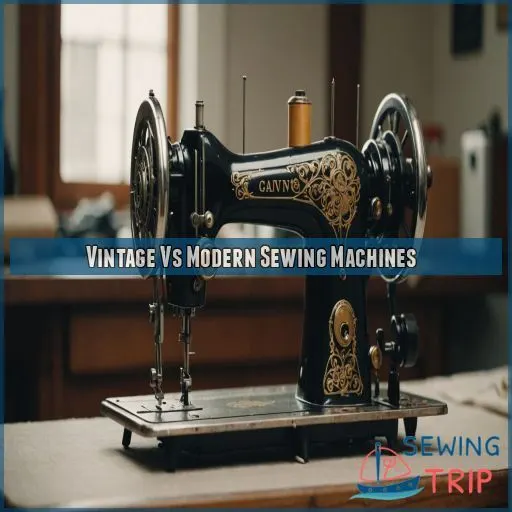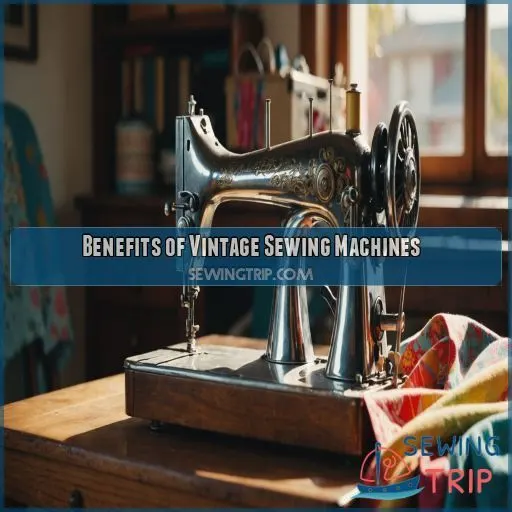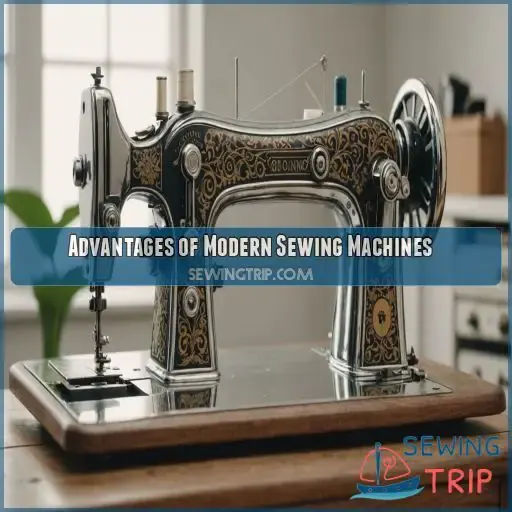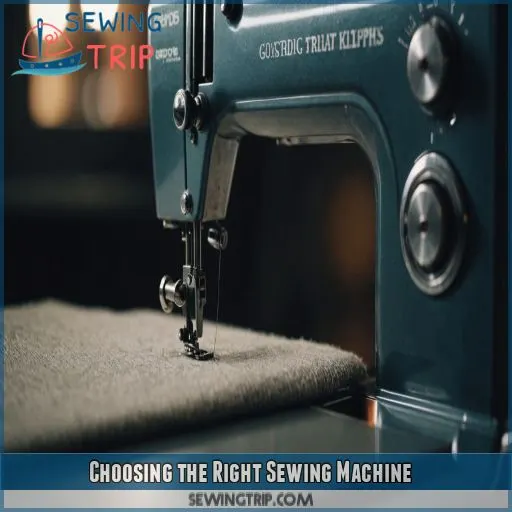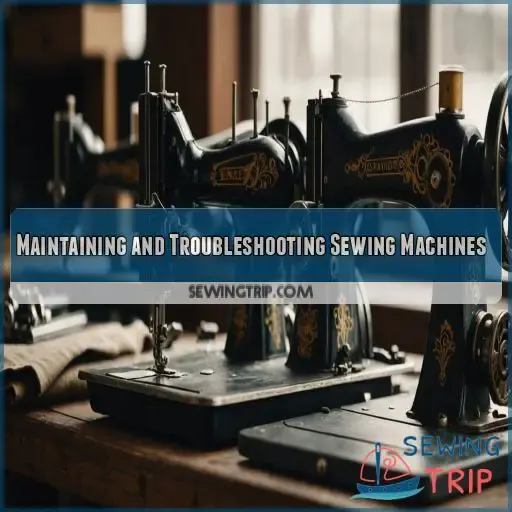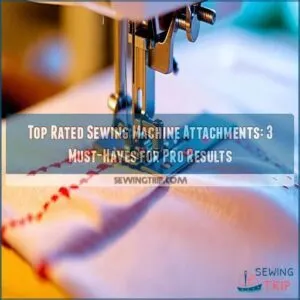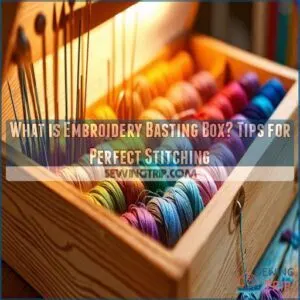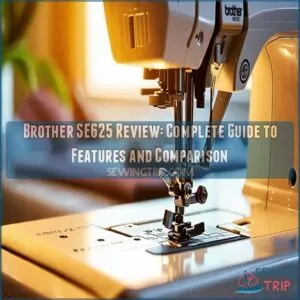This site is supported by our readers. We may earn a commission, at no cost to you, if you purchase through links.
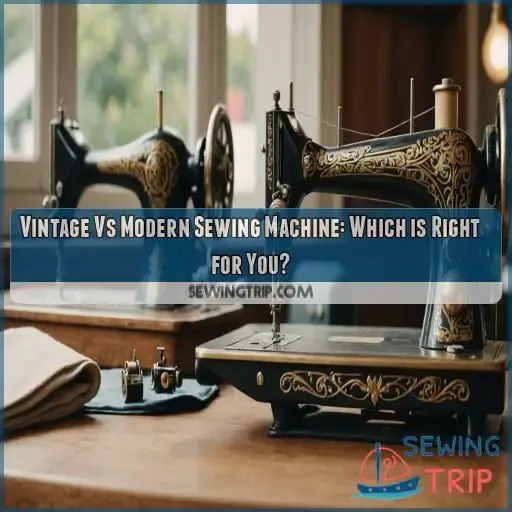 Choosing between a vintage and modern sewing machine is like picking between a classic car and the latest sports model – they each have their own unique charms.
Choosing between a vintage and modern sewing machine is like picking between a classic car and the latest sports model – they each have their own unique charms.
Vintage machines have that nostalgic appeal and are built like tanks.
Modern machines pack all the latest bells and whistles.
The real question is, what’s your sewing style?
If you love the thrill of customizing and tinkering, a vintage machine might be your jam.
But if you crave the convenience of computerized controls and a wide range of stitches, a modern machine could be your new best friend.
Either way, there’s a sewing machine out there that’s perfect for your creative needs choosing a sewing machine.
Table Of Contents
Key Takeaways
- Choosing between a vintage and modern sewing machine is like selecting between a classic car and a high-tech vehicle; one excites with nostalgia and durability, while the other dazzles with the latest features and convenience modern sewing machine features.
- If you love customizing and tinkering, a vintage machine might be your best bet. They’re built tough and cost-effective, but get ready for some elbow grease in repairs and maintenance.
- Modern machines offer automatic features and versatile stitch options, making them a breeze to use even for newcomers. You’ll trade some durability for convenience and efficiency.
- Weigh your sewing needs, budget, and space; whether you live in a palace or a small space, the right machine will fit your lifestyle and inspire your creative journey.
Vintage Vs Modern Sewing Machines
When choosing a sewing machine, deciding between vintage and modern options is a bit like picking between classic vinyl records and the latest streaming apps. You’ll weigh the charm and durability of vintage models against the cutting-edge features and user-friendly designs of modern machines.
Key Differences in Design and Functionality
When comparing vintage and modern sewing machines, the design and functionality are like night and day. Vintage machines often have a charming, old-world aesthetic, with sturdy metal construction and a straightforward, manual operation. In contrast, modern machines boast:
- Multiple stitch options
- Automatic needle threading
- Computerized controls
- Lightweight, portable designs
The choice between vintage and modern ultimately comes down to your sewing needs and personal preferences.
Evolution of Sewing Machine Technology
Imagine your sewing journey through time—embracing automation and smart features today. Modern sewing machines let you dance through stitch varieties with digital embroidery and quick tension adjustments. Vintage charm? It’s like a nostalgic pause, relishing simplicity.
| Feature | Vintage | Modern |
|---|---|---|
| Automation | Manual | Computerized |
| Stitch Variety | Limited | Extensive |
| Embroidery | Basic attachments required | Built-in digital |
| Portability | Heavy, sturdy | Lightweight, portable |
| Adjustments | Manual tension adjustment | Automatic adjustments |
Impact of Modern Materials on Sewing Machine Durability
Previously, we explored how sewing machines have evolved. So, how do modern materials stack up against vintage ones? Modern sewing machines often boast plastic parts—lighter, sure, but do they endure like metal? Durability testing shows metal tends to outlast. Plastic parts might mean quicker needle threader failures or worn bobbin cases, impacting repairs. It’s no fairy tale!
Comparison of Vintage and Modern Machine Prices
Deciphering the cost differences between vintage and modern sewing machines can make your head spin like a bobbin. Here’s the rundown:
- Vintage Machine Value: Often a bargain, yet holds surprising resale value.
- Modern Machine Cost: Higher upfront, but you’re paying for bells and whistles.
- Price Trends: Secondhand modern machines depreciate faster.
- Repair Costs: Vintage repairs might require elbow grease, but are usually cheaper!
Benefits of Vintage Sewing Machines
When you’re eyeing those old-fashioned sewing machines, think of them as the grandparent who still manages to outlast everyone at family functions. They’re not just charming relics; they’re tough, budget-friendly, and ready to handle whatever sewing challenge you throw their way.
Unique Aesthetic Appeal and Nostalgic Value
A vintage sewing machine isn’t just a tool; it’s a piece of history—a nostalgic time capsule. Decorating your home, they whisper stories of past creations. Imagine this:
| Emotion | Look | Feeling |
|---|---|---|
| Nostalgia | Antique brass details | Warmth |
| Heritage | Classic wood cabinets | Elegance |
| Artistry | Intricate iron designs | Inspiration |
Dive into history while enjoying the satisfying click of a straight stitch.
Durability and Long-Lasting Performance
While vintage machines carry a unique charm, their durability and long-lasting performance often steal the spotlight. These workhorses, made from sturdy vintage materials, stand the test of time, meaning fewer repair bills. Imagine them as the tortoises in the sewing world race:
- Longevity over modern machines’ fragility
- Designed for heavy usage
- Repair vs. replace? Less often needed
Cost-Effectiveness and Affordability
While vintage machines boast durability, let’s chat about their cost-effectiveness. These old-time gems are often thrifted at a fraction of modern machine prices, letting your wallet sing with joy. They mightn’t offer the techy modern machine ROI, but dishing out for a budget sewing option means you’re snagging value over time, with flair and charm to boot.
Potential for Customization and Upgrades
With a vintage sewing machine, the possibilities for customization and upgrades are endless. From adding modern features like automatic needle threaders to modifying the aesthetics with a fresh paint job, you can truly make an old machine your own. Explore your creativity and transform a classic into a one-of-a-kind sewing companion.
Advantages of Modern Sewing Machines
When you’re looking for a sewing machine that makes life easier, modern ones are packed with features like automatic needle threading and various stitch options that can be a real time-saver.
They’re also light enough to move around without pulling a muscle, making them perfect for those times when you suddenly need to clear the dining table for other projects, like eating.
Advanced Features and Multiple Stitch Options
With modern sewing machines, you can stitch to your heart’s content using embroidery capabilities and an array of stitch types. It’s like having an artist’s palette at your fingertips! Want to master quilting features or make perfect buttonholes? No problem! Plus, sewing speed is just a dial away, giving you freedom to create with ease and accuracy.
Automatic Needle Threading and Computerized Controls
You’ve seen advanced stitch options, but let’s chat about features that make sewing a breeze. Modern machines come with automatic needle threading—no more squinting! With computerized controls, you’re the conductor in a symphony of fabric and stitching. Customize with ease, navigate error codes like a pro, and enjoy digital connectivity, making sewing as smooth as silk.
Improved User-Friendliness and Ease of Use
With modern sewing machines, you’ll enjoy an intuitive, user-friendly experience. Automatic needle threading takes the hassle out of setup, while simplified stitch selection and responsive foot pedals make it a breeze to sew. Helpful error messages guide you through any issues, so you can focus on expressing your creativity without the frustration.
Increased Portability and Space-Saving Design
Given today’s compact sewing machine designs, it’s like having a magic carpet that’s ready to whisk you anywhere, anytime! Perfect for small apartments or travel sewing kits, these machines can nestle on a bookshelf. Explore sewing machine storage solutions and space-saving sewing desk ideas. Don’t forget portable sewing machine accessories turning any nook into your creative paradise!
Choosing the Right Sewing Machine
Choosing the right sewing machine doesn’t have to be difficult if you know what you need and can afford. Whether you’re stitching a simple dress or piecing together a quilt that rivals Grandma’s, aligning your skills and space with the perfect machine will keep you and your wallet happy.
Assessing Your Sewing Experience and Project Needs
Let’s face it: sewing isn’t one-size-fits-all. Whether you’re stitching a delicate scarf or crafting a quilt as big as a bed, your sewing skill level and project needs shape your choice. Consider:
- Project complexity: Are you tackling intricate details?
- Fabric types: From silk to denim, what’s your go-to?
- Sewing space: Do you live in a palace or a shoebox?
Setting a Budget and Evaluating Machine Prices
When choosing a sewing machine, set a realistic budget that fits your needs and lifestyle.
Compare prices across vintage and modern models to find the best value.
Consider the long-term cost-benefit. A higher upfront investment in a quality machine may pay off in durability and resale value down the line.
The right machine is an investment in your creative journey.
Considering Machine Size and Space Requirements
Sizing up sewing machines is key comparing sewing machine types! If you’re working in a cozy nook or a bustling sewing room, consider compact models for space-saving designs. Modern machines often offer portability, perfect for moving around. Vintage beauties may need permanent parking. Think about storage solutions—nobody likes a cluttered workspace. Remember, sewing shouldn’t be a game of Twister!
Maintaining and Troubleshooting Sewing Machines
Maintaining your sewing machine, whether it’s a treasured vintage piece or a sleek modern model, isn’t as hard as it seems and can save you a lot of hassle down the line. If you find yourself coaxing your machine along with the promise of a reward if it plays nice, it’s time for some TLC and those handy troubleshooting tips.
Regular Cleaning and Lubrication for Vintage Machines
After you’ve chosen your perfect sewing companion, keeping it spick and span is a must. Here’s how:
- Grab your Cleaning Tools for dust bunnies lurking beneath the surface.
- Apply a quality Lubricant to moving parts, ensuring smooth stitching.
- Stick to a regular schedule for Preventative Maintenance.
Your Vintage Sewing Machine Care routine isn’t rocket science; it’s more like a dance!
Adjusting Bobbin Tension and Replacing Needles
Adjusting your bobbin tension and replacing needles are essential maintenance tasks for keeping your sewing machine running smoothly.
Check the bobbin tension regularly, making minor tweaks as needed.
And don’t forget to swap out that needle – a fresh, sharp one makes all the difference in your stitching quality.
Trust your instincts and don’t be afraid to experiment until you find the perfect settings.
Inspecting Electrical Wiring and Seeking Professional Help
After adjusting the bobbin tension and replacing needles, don’t overlook vintage machine safety—pay attention to electrical hazards. Flickering lights or odd smells? It’s time to call certified electricians. Remember, DIY repairs can increase repair costs if something goes wrong. Avoid shocking surprises; a professional’s expertise puts you in the driver’s seat while keeping your machine running smoothly.
Common Issues With Modern Machines and Troubleshooting Tips
When modern sewing machines throw you a curveball with needle jamming or thread breakage, don’t lose your cool! Often, adjusting tension solves issues, while regular cleaning prevents motor problems and foot pedal issues. Error messages? They’re just your machine’s quirky way of asking for attention. Remember, every hiccup’s just another step toward mastering your sewing sorcery!
Frequently Asked Questions (FAQs)
What is the difference between old and new sewing machines?
Choosing between old and new sewing machines is like picking between classic rock vinyl and the latest streaming hits—both have their own charm and appeal. Choosing the right machine depends on your sewing goals, budget, and personal preferences. Vintage machines charm with durability and character, while modern ones dazzle with tech features and ease of use.
Is it worth buying a vintage sewing machine?
Buying a vintage sewing machine is like adopting a cherished heirloom; it offers durability and charm. It’s cost-effective, reliable, and can sew straight for days! Just keep it maintained, and it’ll sew through time like a dream.
Are modern sewing machines easier to use?
Yes, modern sewing machines are generally easier to use than vintage models. With features like automatic needle threadingd computerized controls, today’s machines are designed for user-friendliness, making sewing more accessible for beginners and experienced sewers alike.
What makes a sewing machine vintage?
Think of vintage sewing machines as wise elders: built to last, oozing charm, and crafted before They evoke nostalgia, offer straightforward functionality, and require a bit more TLC to keep them humming smoothly.
How do vintage sewing machines compare in noise level?
Vintage sewing machines can be quiet like a cat’s purr or rattle like a rattlesnake, depending on maintenance. With regular oiling, they’re generally quieter than you might think. It’s all about how you care for them!
What safety features do modern sewing machines offer?
Did you know 80% of modern sewing machines boast safety features? You’ll find needle guards, automatic thread cutters, and finger guards, ensuring a safer sewing experience. Safety first, or you’ll be "sew" sorry!
Are vintage sewing machines compatible with modern patterns?
Absolutely, vintage sewing machines can handle modern patterns. You might need to adjust the stitch type manually or use attachments for special designs, but they’ll stitch through like a hot knife through butter with timeless reliability.
How does the cost of repairs compare between the two?
Repairing vintage sewing machines can be cheaper as parts are often more accessible and you might fix them yourself. Modern machines, with their high-tech components, may require professional service, making repairs potentially costlier and complex.
Can modern machines replicate the stitch quality of vintage models?
In a world of horse-drawn carriages, vintage machines often boast superior stitch quality due to their robust build. Modern machines can match this quality with technological advancements, like precise computerized controls, offering you the best of both worlds.
Conclusion
Ultimately, the choice between a vintage or modern sewing machine boils down to your personal sewing style and preferences.
If you’re a vintage enthusiast who relishes the thrill of customization, a classic machine may be your perfect match.
But if you crave the convenience of modern technology, a feature-packed contemporary model could be your new best friend.
Whichever route you choose, the right vintage or modern sewing machine will elevate your creative journey and bring your sewing dreams to life.

